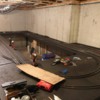As stated by others above, with DCS you definitely want to create blocks (isolated sections) of track (10-12 track joints per block). Isolate the center rail between each block. They refer to this as a 'star pattern' (as opposed to bus wiring, 'daisy chain'). Feed each block in the center of the block with a pair of wires, one to center rail (red, hot) and one to outside rail (black, common) and wire them back to the 'distribution terminal block. For me it was easiest to use an MTH terminal block, they are specifically made for wiring DCS systems and work great, very easy, no crimp connectors needed, just hook up the wires.
Also note that Atlas track does not have anything built in to connect the two outside rails, they are totally separate. So make sure you use the same outside rail at each power feed or jumper the outside rails together. Many like to leave one outside rail for signaling, operating accessories (isolated rail) and other things. This is what I did on my layout, left one outside rail separate and not connected to common.
It looks like you have two loops of track, so it might also be a good idea to separate the loops at the crossovers and power one with one TIU channel and the second with another TIU channel. I did that here as well. If you currently have only one PH-180 for power, I would wire for two separate loops and power supplies and then just jumper the two TIU inputs at the TIU for now until you need to add the second one in the future. I would use one MTH terminal block for each loop. Much easier to wire this way now than to have to go back and change things later. From each MTH terminal block you would wire on pair of wire back to the TIU channel for the appropriate loop.
Another note, if you do expand to two power supplies you should power your TIU from the AUX port using a totally separate power supply. If you only use the one PH-180 FXD In 1 has to be powered to power the TIU, unless you are already [planning to use the AUX port with separate power supply.
I would also isolate the center rail of each siding or spur, also mentioned above I think, and feed those with a pair of wires to the siding or spur. In those feed wires I would install a SPST (On/Off) switch somewhere near your 'control center' or other easy access point where you will spend most of your time running trains. That way you can park engines and turn off the power to keep the hours/on time from accumulating while they just sit there.
If you don't have Barry's book, I would order a copy of that as well. It's worth every penny and also describes all this wiring much better than I do. It's also a reference you will refer to time and again over the years, at least I do anyway.
Hope I didn't further confuse the issue for you and this somewhat makes sense. Creating blocks as I tried to describe eliminated all of my DCS errors and problems. Haven't had one in a few years, that is unless it was something stupid I did myself... I also use Atlas track and switches and have been very happy with all of it, FWIW.












